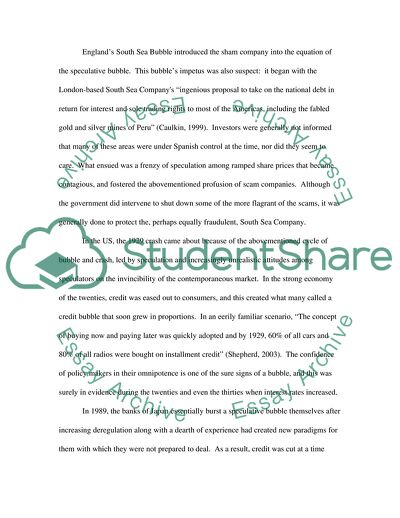
- Home
- Free Samples
- Premium Essays
- Editing Services
- Extra Tools
- Essay Writing Help
- About Us
- Studentshare
- Subjects
- Miscellaneous
- Stock Markets Bubbles
Stock Markets Bubbles - Essay Example

- Subject: Miscellaneous
- Type: Essay
- Level: Undergraduate
- Pages: 4 (1000 words)
- Downloads: 0
- Author: bwisoky
Extract of sample "Stock Markets Bubbles"
f control, with the surest sign being mass speculation in tulips to the detriment of other parts of the economy that had been operating with stability for years. It was truly a sort of mania that seized speculators. England’s South Sea Bubble introduced the sham company into the equation of the speculative bubble. This bubble’s impetus was also suspect: it began with the London-based South Sea Companys “ingenious proposal to take on the national debt in return for interest and sole trading rights to most of the Americas, including the fabled gold and silver mines of Peru” (Caulkin, 1999).
Investors were generally not informed that many of these areas were under Spanish control at the time, nor did they seem to care. What ensued was a frenzy of speculation among ramped share prices that became contagious, and fostered the abovementioned profusion of scam companies. Although the government did intervene to shut down some of the more flagrant of the scams, it was generally done to protect the, perhaps equally fraudulent, South Sea Company. In the US, the 1929 crash came about because of the abovementioned cycle of bubble and crash, led by speculation and increasingly unrealistic attitudes among speculators on the invincibility of the contemporaneous market.
In the strong economy of the twenties, credit was eased out to consumers, and this created what many called a credit bubble that soon grew in proportions. In an eerily familiar scenario, “The concept of buying now and paying later was quickly adopted and by 1929, 60% of all cars and 80% of all radios were bought on installment credit” (Shepherd, 2003). The confidence of policy makers in their omnipotence is one of the sure signs of a bubble, and this was surely in evidence during the twenties and even the thirties when interest rates increased.
In 1989, the banks of Japan essentially burst a speculative bubble themselves after increasing deregulation along with a dearth of experience had
...Download file to see next pages Read MoreCHECK THESE SAMPLES OF Stock Markets Bubbles
Argument of After Shock
The Chinese Stock Bubble 2007
How Monetary Policy Can Influence the Stock Market Bubbles
The Influence of Behavioural Finance on Stock Markets
Stock Market Bubbles, Investing in Stock Markets in Different Countries
The Nature of the Economic Bubbles
The Theory of Credit Boom Bubble
Technical Analysis and Efficient Market Hypothesis

- TERMS & CONDITIONS
- PRIVACY POLICY
- COOKIES POLICY